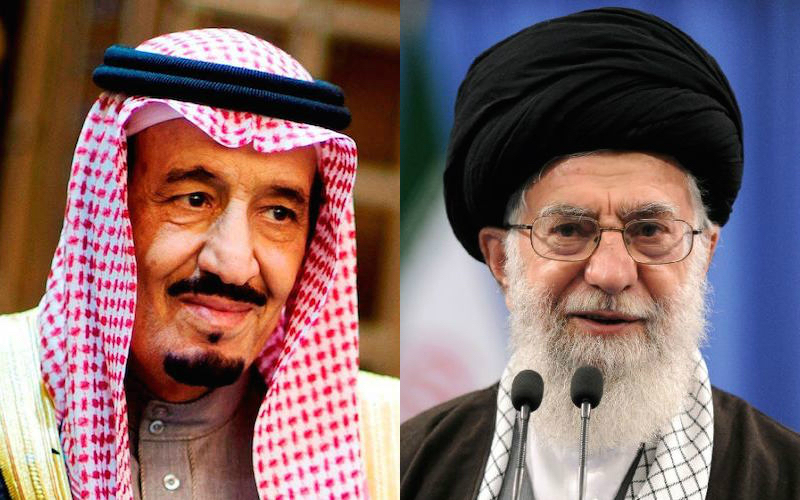
For Mideast Peace, Iran–Saudi Rapprochement is the First Step
Iran and Saudi Arabia, traditional rivals in the Middle East, have emerged as leading actors in regional politics. Today, their rivalry and competition for power and influence largely define the political dynamics and diplomatic matrix of the region, in a marked shift from the past. Until recently, the U.S. was the mighty arbiter that attempted to dictate developments and force its choices onto the region, primarily to protect Israel and oil interests. Bill Clinton’s “dual containment” policy in the 1990s or George W. Bush’s post-2003 “democracy promotion” slogans are just two oft-cited examples. That is no longer the case, as America’s “imperial overstretch,” under the rubric of “war on terror,” to permanently create a pro-American regional order has mostly failed.
The gradual U.S. decline has seen a rise in Iranian and Saudi influence. Post-2003 Iran–Saudi geopolitical competition, unleashed by the U.S. invasion of Iraq and the Arab pro-democracy movements, expanded their grip over regional politics in two different but related ways. Both of them rushed to defend and promote their geopolitical interests by siding with their cross-border allies and groups in Iraq, Syria and Yemen, and thus developed their respective regional alliance networks. Secondly, America failed or was unable to put a brake on Iran–Saudi fierce rivalry for power and influence.
President Bush hardly succeeded in containing the bloody sectarian war in Iraq between 2006 and 2008 and his successor President Obama seems to have settled for a policy of gradual disengagement from the region. The Obama administration withdrew from Iraq in December 2011 but again returned in mid-2014 to fight the Islamic State, refused to bomb President Assad’s forces to effect regime change in Damascus, brought U.S.–Israel relations to a new low through half-hearted efforts to resolve the Israel–Palestine conflict, and finally signed a historic but unsustainable nuclear deal with Iran in July 2015 by defying the hawks in Washington, Tel Aviv and Riyadh.
The Iran–U.S. nuclear deal, among other developments, further ratcheted up tensions in Iran’s relations with Saudi Arabia as well as Israel. For Washington and Tehran the deal was the Holy Grail to avoid war, but for Riyadh and Tel Aviv it was their new Achilles’ heel in the Middle East. The Saudis and the Israelis interpreted the deal as a major concession to Iran and were appalled by the prospects of Iran’s rise as a dominant regional power. After unsuccessful attempts to foil the deal, they made a series of zero-sum calculations: that Iran’s rise would surely shrink their room for maneuver in the region or that an unfettered Iran, in the absence of U.S.-led Western sanctions, would gradually rise to a hegemonic position in the Middle East’s poly nodal power structure to dictate regional affairs.
The Saudis were especially nervous that a nuclear Iran, to be eventually facilitated by the deal after fifteen years, would force the Arab states to seek Tehran’s prior approval on all regional policy issues or that actions on every regional issue must pass through Tehran. To compensate for weaknesses, Riyadh first formed a 9-nation Arab Coalition to back up its war efforts to crush the Iran-supported Shia Houthi rebels in Yemen and thereafter launched a loosely knit 34-nation Islamic military alliance to square off against Iran, a policy that some analysts have dubbed the “Salman doctrine.”
Rationale for Rapprochement
That Iran–Saudi geopolitical competition is largely endangering Mideast regional peace is beyond dispute, while their cooperation is absolutely necessary to avoid a regional Armageddon. The rationale for rapprochement between them emerges from a series of harsh realities: nearly half a million Iraqis have been killed between 2003 and 2011; George Bush’s 12 years of “war on terror” has resulted in a massive kill of 1.3 million people in the three war zones of Iraq, Afghanistan and Pakistan. The fight against the Islamic State has further aggravated the situation, with civilians being bombed, mistakenly or not, by different coalition jets or targeted by suicide bombers. No less consequential are Iranian and Saudi contributions to this mayhem.
Iran’s financial and military aid package to the Syrian government, according to one source, amounts to $6 billion per year, though it is domestically plagued with multiple serious economic ills. Saudi Arabia, supported by the U.S., Qatar and the UAE, is the principal supplier of arms and money to the Syrian rebel groups, and spends $6 billion every month for the air campaign for the war in Yemen. The ultimate outcomes are more than gruesome: by the end of 2015, a total of 470,000 Syrians were killed, with another 1.9 million wounded and a huge economic loss of $255 billion incurred. In Yemen, the Arab world’s poorest country, some 10,000 people have already lost their lives, with children being the principal victims of the war, and the country’s economy and infrastructure going into total disarray.
The dire situations in Iraq, Syria and Yemen call for a reassessment of this highly damaging Iran–Saudi competition for regional dominance. A move from conflict to cooperation by the two rivals may not be as difficult, as it might seem. Although known for pursuing confrontational regional politics, Iran and Saudi Arabia have had a good record of mutual cooperation. Under President Nixon’s “twin pillar” policy, they collectively played decisive roles to combat communist threats across the region, particularly in Oman, the now defunct North Yemen, and Somalia. On the bilateral front, their ties substantially improved during the reign of King Abdullah bin Abd al-Aziz Al-Saud and the presidencies of two former Iranian presidents – Hashemi Rafsanjani and Mohammad Khatami. King Abdullah and President Khatami succeeded in signing two landmark agreements to promote mutual trust and cooperation between the two Gulf neighbors – the comprehensive agreement of 1998, and the security pact of 2001 to jointly deal with al-Qaeda.
In the past, a set of common threats pushed Riyadh and Tehran to occasionally set aside their rivalry and cooperate. Common dangers like the post-war potential Soviet communist threats to penetrate the Gulf, the secular Arab Ba’athists in Iraq under Saddam Hussein or al-Qaeda pushed them to cooperate, on many different occasions. Such common threats are mostly non-existent today. The Islamic State has emerged as a menace but the Saudis seem to view it less as a severe threat, than as a front against the Shias, while for Iran it poses an existential threat.
Common threats or not, the ugly realities in the Middle East call for an immediate Iran–Saudi détente. The question is: Who will take the shot at initiating negotiations to come out of the morass? Last year, Iranian Supreme Leader Ali Khamenei called on Iranian negotiators to show “heroic flexibility” to resolve the nuclear dispute with the U.S. Today this “heroic flexibility” is again required for a Saudi–Iran breakthrough to drag the Middle East out of violence and carnage.

